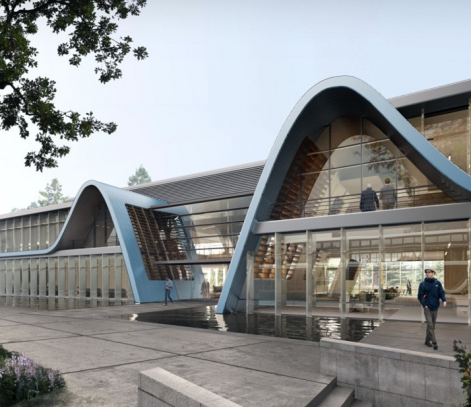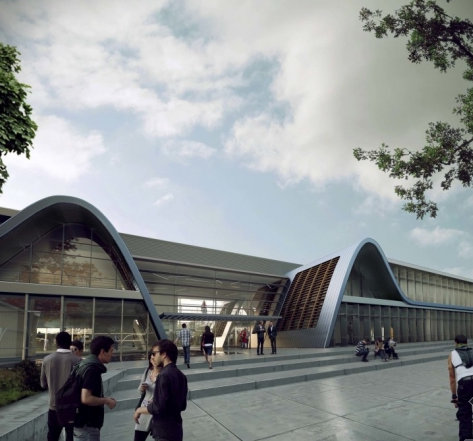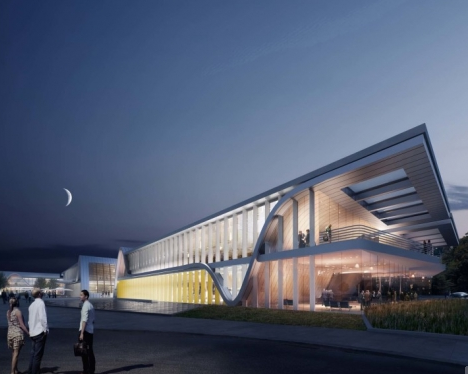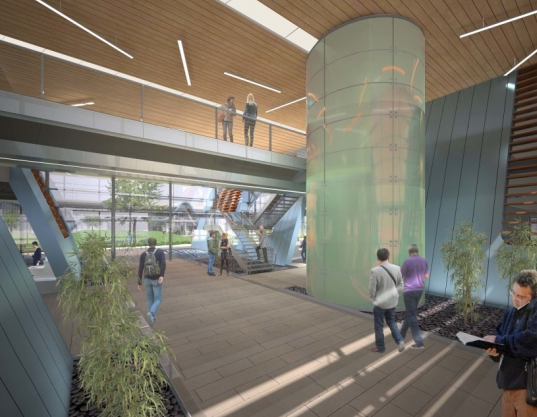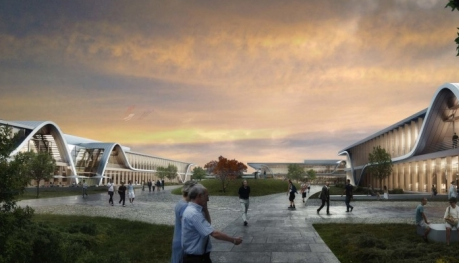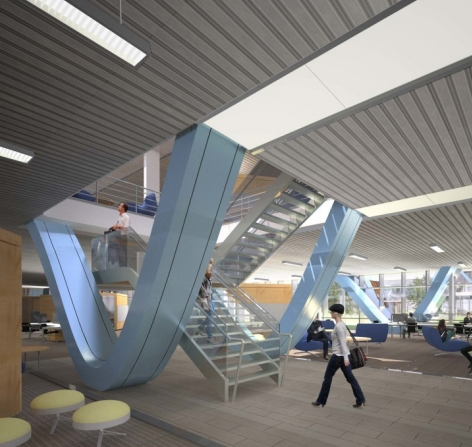The dynamic architecture of the Innovation Curve Technology Park at Stanford
Research Park celebrates the creative process of invention. The peaks and
valleys of sweeping metal curves serve as architectural metaphors for the highs
and lows of exploratory research and development. Located on the edge of
Stanford Research Park in Palo Alto, the site will become an uplifting campus
for tenants involved with computer gaming, translation software, and digital
inventions. The project—designed to earn a LEED- Platinum rating—is currently
under construction, with anticipated completion in 2017.
Designed by
Form4 Architecture of San Francisco, the new 13.5-acre Palo Alto campus
developed by Sand Hill Property Company comprises four buildings, totaling
265,895 square feet. Representing the diagram of innovation on the face of the
buildings, the lyrical design serves as a potent visual reminder of the
dedicated, expansive, and intense work taking place inside. “The Innovation
Curve is a billboard of effervescent thinking characteristic of the
entrepreneurial spirit of Silicon Valley,” says John Marx, AIA, design principal
at Form4 Architecture.
In addition to Innovation Curve, Form4 has
designed expressive headquarters and interiors for Netflix, VMware, Workday, and
DayNine, as well as several office buildings intended for a variety of
innovative tech companies. “We have been on the forefront of an evolution from
Silicon Valley’s utilitarian/manufacturing roots toward an architecture of
increased intellectual creativity and worker vitality that stimulates community
engagement,” notes Marx. The Innovation Curve is one of several Form4 designs
currently featured at the “Time-Space-Existence” exhibition in conjunction with
the 2016 Venice Architecture Biennale.
The Innovation Curve buildings are
arranged around a central landscaped courtyard with diagonal pedestrian paths
leading from adjacent streets through the site. Each 35-foot-tall structure
comprises two offset wings flanking a central, glass-faced lobby to break up the
building mass. In the lobby, both the concrete courtyard paving and metal curves
of the building exterior extend through the two-story space to create a
sculptural portal connected to the outdoors.
On the building exteriors,
projecting roofs and deep overhangs—to be fabricated of painted recycled
aluminum—are configured to express the roller-coaster evolution of innovation.
The tall, two-story curves rise to represent the crescendo of the creative spark
and pragmatic analysis of ideas, and descend to transition into long, horizontal
bands symbolizing the implementation phase of invention. The architecture of the
new research park captures the forward-leaning spirit of technology in metal and
glass, evoking machined precision, transparency, and modernity. “The process of
creativity is made visible in three dimensions,” says Robert J. Giannini,
president of Form 4 Architecture.The overhangs curving downward to low points
near the ground capture the challenging process of risk assessment, market
financing, and decision-making. From there, they rise to the ends of each
building to express an uplifting conclusion to the innovation diagram. These
projecting planes supply outdoor balconies offering vistas of the campus and the
bits and bytes world outside the technology park.
In addition to their
symbolic significance, the deep overhangs work in combination with vertical
glass fins to shade the building exteriors, control solar heat gain, and allow
for greater transparency and connection to campus life. To allow for more
exterior glass, deep horizontal sunshades, which also act as light shelves,
extend from perimeter walls. Solar-controlled skylights augment the daylighting
scheme to reduce the need for artificial illumination. Aiming to achieve
LEED-Platinum certification, the building incorporates additional sustainable
elements, such as automated shade infrastructure, high-efficiency mechanical and
electrical systems, high-performance cool roofs, solar photovoltaic power
generation, recycling of construction waste, locally sourced materials, and
bioswales landscaped with native plants. The sustainable features contribute to
significant increase in thermal comfort for the occupants, which results in
higher occupant satisfaction and productivity, as well as a gentle wear on
mechanical systems.
Form4 Architecture believes architecture is the art of giving form to ideas. The award-winning firm specializes in creating environments, whether for tech offices mixed-use developments, or residences, that respond as equally to the topography of a site as they do to the people they serve. Form4 creates formal expressions that are not only poetically moving and conceptually thoughtful, but also reflective of the client’s values and goals. As collaborative partners in the design process, the principals of Form4 Architecture— Robert J. Giannini, John Marx, AIA, Paul Ferro, AIA, and James Tefend, AIA—are personally involved with every project from concept to completion, bringing the collective wealth of years of expertise and knowledge to each client's vision. Since 1999, the firm has built a rich portfolio of award-winning work for national and international clients within diverse market sectors.www.gdvogue.com
